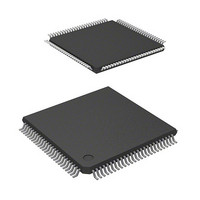DF2148RTE20IV Renesas Electronics America, DF2148RTE20IV Datasheet - Page 553

DF2148RTE20IV
Manufacturer Part Number
DF2148RTE20IV
Description
MCU 5V 128K I-TEMP,PB-FREE, 100-
Manufacturer
Renesas Electronics America
Series
H8® H8S/2100r
Specifications of DF2148RTE20IV
Core Processor
H8S/2000
Core Size
16-Bit
Speed
20MHz
Connectivity
Host Interface, I²C, IrDA, SCI
Peripherals
POR, PWM, WDT
Number Of I /o
74
Program Memory Size
128KB (128K x 8)
Program Memory Type
FLASH
Ram Size
4K x 8
Voltage - Supply (vcc/vdd)
4 V ~ 5.5 V
Data Converters
A/D 8x10b; D/A 2x8b
Oscillator Type
Internal
Operating Temperature
-40°C ~ 85°C
Package / Case
100-TQFP, 100-VQFP
Lead Free Status / RoHS Status
Lead free / RoHS Compliant
Eeprom Size
-
- Current page: 553 of 1179
- Download datasheet (7Mb)
Bit 3—Acknowledge Bit Judgement Selection (ACKE): Specifies whether the value of the
acknowledge bit returned from the receiving device when using the I
and continuous transfer is performed, or transfer is to be aborted and error handling, etc.,
performed if the acknowledge bit is 1. When the ACKE bit is 0, the value of the received
acknowledge bit is not indicated by the ACKB bit, which is always 0.
In the H8S/2148 Group and H8S/2147N, the DTC can be used to perform continuous transfer. The
DTC is activated when the IRTR interrupt flag is set to 1 (IRTR is one of two interrupt flags, the
other being IRIC). When the ACKE bit is 0, the TDRE, IRIC, and IRTR flags are set on
completion of data transmission, regardless of the value of the acknowledge bit. When the ACKE
bit is 1, the TDRE, IRIC, and IRTR flags are set on completion of data transmission when the
acknowledge bit is 0, and the IRIC flag alone is set on completion of data transmission when the
acknowledge bit is 1.
When the DTC is activated, the TDRE, IRIC, and IRTR flags are cleared to 0 after the specified
number of data transfers have been executed. Consequently, interrupts are not generated during
continuous data transfer, but if data transmission is completed with a 1 acknowledge bit when the
ACKE bit is set to 1, the DTC is not activated and an interrupt is generated, if enabled.
Depending on the receiving device, the acknowledge bit may be significant, in indicating
completion of processing of the received data, for instance, or may be fixed at 1 and have no
significance.
Bit 2—Bus Busy (BBSY): The BBSY flag can be read to check whether the I
is busy or free. In master mode, this bit is also used to issue start and stop conditions.
A high-to-low transition of SDA while SCL is high is recognized as a start condition, setting
BBSY to 1. A low-to-high transition of SDA while SCL is high is recognized as a stop condition,
clearing BBSY to 0.
To issue a start condition, use a MOV instruction to write 1 in BBSY and 0 in SCP. A retransmit
start condition is issued in the same way. To issue a stop condition, use a MOV instruction to
write 0 in BBSY and 0 in SCP. It is not possible to write to BBSY in slave mode; the I
interface must be set to master transmit mode before issuing a start condition. MST and TRS
should both be set to 1 before writing 1 in BBSY and 0 in SCP.
Bit 3
ACKE
0
1
The value of the acknowledge bit is ignored, and continuous transfer
is performed
If the acknowledge bit is 1, continuous transfer is interrupted
Description
Rev. 4.00 Sep 27, 2006 page 507 of 1130
Section 16 I
2
C bus format is to be ignored
2
C Bus Interface [Option]
2
C bus (SCL, SDA)
REJ09B0327-0400
(Initial value)
2
C bus
Related parts for DF2148RTE20IV
Image
Part Number
Description
Manufacturer
Datasheet
Request
R

Part Number:
Description:
KIT STARTER FOR M16C/29
Manufacturer:
Renesas Electronics America
Datasheet:

Part Number:
Description:
KIT STARTER FOR R8C/2D
Manufacturer:
Renesas Electronics America
Datasheet:

Part Number:
Description:
R0K33062P STARTER KIT
Manufacturer:
Renesas Electronics America
Datasheet:

Part Number:
Description:
KIT STARTER FOR R8C/23 E8A
Manufacturer:
Renesas Electronics America
Datasheet:

Part Number:
Description:
KIT STARTER FOR R8C/25
Manufacturer:
Renesas Electronics America
Datasheet:

Part Number:
Description:
KIT STARTER H8S2456 SHARPE DSPLY
Manufacturer:
Renesas Electronics America
Datasheet:

Part Number:
Description:
KIT STARTER FOR R8C38C
Manufacturer:
Renesas Electronics America
Datasheet:

Part Number:
Description:
KIT STARTER FOR R8C35C
Manufacturer:
Renesas Electronics America
Datasheet:

Part Number:
Description:
KIT STARTER FOR R8CL3AC+LCD APPS
Manufacturer:
Renesas Electronics America
Datasheet:

Part Number:
Description:
KIT STARTER FOR RX610
Manufacturer:
Renesas Electronics America
Datasheet:

Part Number:
Description:
KIT STARTER FOR R32C/118
Manufacturer:
Renesas Electronics America
Datasheet:

Part Number:
Description:
KIT DEV RSK-R8C/26-29
Manufacturer:
Renesas Electronics America
Datasheet:

Part Number:
Description:
KIT STARTER FOR SH7124
Manufacturer:
Renesas Electronics America
Datasheet:

Part Number:
Description:
KIT STARTER FOR H8SX/1622
Manufacturer:
Renesas Electronics America
Datasheet:

Part Number:
Description:
KIT DEV FOR SH7203
Manufacturer:
Renesas Electronics America
Datasheet:










